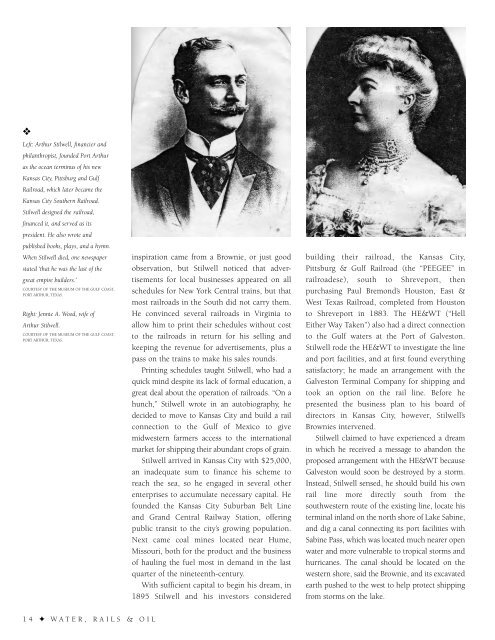Water Rails & Oil - Historic Mid & South Jefferson County
An illustrated history of the Mid and South Jefferson County area, paired with the histories of companies, families and organizations that make the region great.
An illustrated history of the Mid and South Jefferson County area, paired with the histories of companies, families and organizations that make the region great.
You also want an ePaper? Increase the reach of your titles
YUMPU automatically turns print PDFs into web optimized ePapers that Google loves.
❖<br />
Left: Arthur Stilwell, financier and<br />
philanthropist, founded Port Arthur<br />
as the ocean terminus of his new<br />
Kansas City, Pittsburg and Gulf<br />
Railroad, which later became the<br />
Kansas City <strong>South</strong>ern Railroad.<br />
Stilwell designed the railroad,<br />
financed it, and served as its<br />
president. He also wrote and<br />
published books, plays, and a hymn.<br />
When Stilwell died, one newspaper<br />
stated ‘that he was the last of the<br />
great empire builders.’<br />
COURTESY OF THE MUSEUM OF THE GULF COAST,<br />
PORT ARTHUR, TEXAS.<br />
Right: Jennie A. Wood, wife of<br />
Arthur Stilwell.<br />
COURTESY OF THE MUSEUM OF THE GULF COAST,<br />
PORT ARTHUR, TEXAS.<br />
inspiration came from a Brownie, or just good<br />
observation, but Stilwell noticed that advertisements<br />
for local businesses appeared on all<br />
schedules for New York Central trains, but that<br />
most railroads in the <strong>South</strong> did not carry them.<br />
He convinced several railroads in Virginia to<br />
allow him to print their schedules without cost<br />
to the railroads in return for his selling and<br />
keeping the revenue for advertisements, plus a<br />
pass on the trains to make his sales rounds.<br />
Printing schedules taught Stilwell, who had a<br />
quick mind despite its lack of formal education, a<br />
great deal about the operation of railroads. “On a<br />
hunch,” Stilwell wrote in an autobiography, he<br />
decided to move to Kansas City and build a rail<br />
connection to the Gulf of Mexico to give<br />
midwestern farmers access to the international<br />
market for shipping their abundant crops of grain.<br />
Stilwell arrived in Kansas City with $25,000,<br />
an inadequate sum to finance his scheme to<br />
reach the sea, so he engaged in several other<br />
enterprises to accumulate necessary capital. He<br />
founded the Kansas City Suburban Belt Line<br />
and Grand Central Railway Station, offering<br />
public transit to the city’s growing population.<br />
Next came coal mines located near Hume,<br />
Missouri, both for the product and the business<br />
of hauling the fuel most in demand in the last<br />
quarter of the nineteenth-century.<br />
With sufficient capital to begin his dream, in<br />
1895 Stilwell and his investors considered<br />
building their railroad, the Kansas City,<br />
Pittsburg & Gulf Railroad (the “PEEGEE” in<br />
railroadese), south to Shreveport, then<br />
purchasing Paul Bremond’s Houston, East &<br />
West Texas Railroad, completed from Houston<br />
to Shreveport in 1883. The HE&WT (“Hell<br />
Either Way Taken”) also had a direct connection<br />
to the Gulf waters at the Port of Galveston.<br />
Stilwell rode the HE&WT to investigate the line<br />
and port facilities, and at first found everything<br />
satisfactory; he made an arrangement with the<br />
Galveston Terminal Company for shipping and<br />
took an option on the rail line. Before he<br />
presented the business plan to his board of<br />
directors in Kansas City, however, Stilwell’s<br />
Brownies intervened.<br />
Stilwell claimed to have experienced a dream<br />
in which he received a message to abandon the<br />
proposed arrangement with the HE&WT because<br />
Galveston would soon be destroyed by a storm.<br />
Instead, Stilwell sensed, he should build his own<br />
rail line more directly south from the<br />
southwestern route of the existing line, locate his<br />
terminal inland on the north shore of Lake Sabine,<br />
and dig a canal connecting its port facilities with<br />
Sabine Pass, which was located much nearer open<br />
water and more vulnerable to tropical storms and<br />
hurricanes. The canal should be located on the<br />
western shore, said the Brownie, and its excavated<br />
earth pushed to the west to help protect shipping<br />
from storms on the lake.<br />
14 ✦ WATER, RAILS & OIL
















